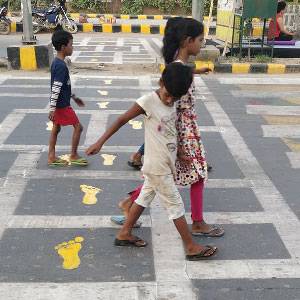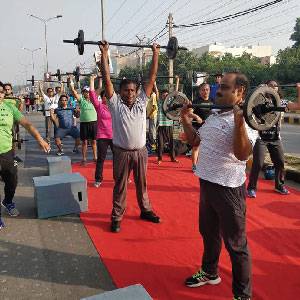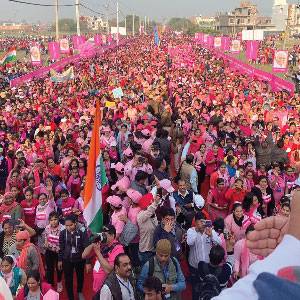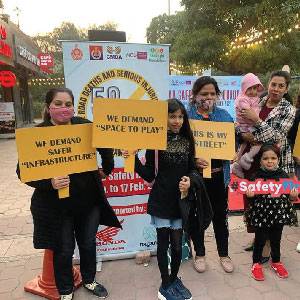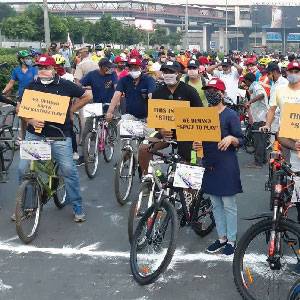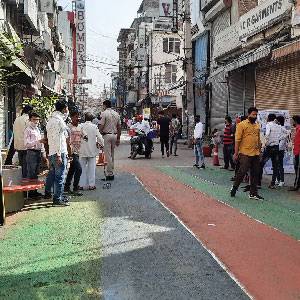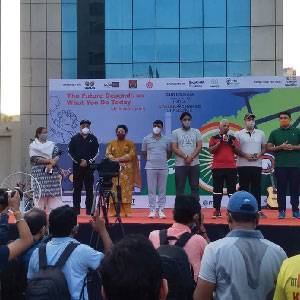HOW GURGAON WALKS
Every year, far too many lives are lost on the streets of Gurgaon, due to its ill-designed and unsafe roads. In 2021 alone, there were 125 pedestrian deaths in Gurgaon, which accounted for 31% of the total road accident fatalities in the city. Gurgaonites, however, are not necessarily at fault for how Gurgaon walks.
Although Gurgaon may seem like one of the most developed cities in India because of its grand buildings and wide roads, it has the reputation of being one of the least walkable cities in Haryana. In fact, the city has an average walkability index of only 0.45 out of 5, which reflects “an overall poor condition.” To add to that, 48% of all daily trips in Gurgaon are taken on foot, but only 28% of its arterial roads have footpaths.
What is Walkability?
Walkability refers to the suitability of a city to pedestrians. Some parameters of walkability include the availability, width and physical condition of footpaths, curb height, and presence of encroachments. Residential density, street connectivity and land use mix are a few of the other determinants of walkability.
In Gurgaon, 74% of the city’s footpaths are in a state that is both unusable and not secure for pedestrians. Aggravating the issue is that many of the available footpaths are often unjustly occupied by parked vehicles and street vendors.

We conducted a small survey asking a few Gurgaonion to describe their experience with walkability in the city. Most respondents answered that the areas they lived in were unsafe for pedestrians. Moreover, almost all the respondents were car users, which further speaks to the ease of commuting by vehicles due to the infrastructure design that caters specifically to them. For the most part, people responded that they walk only one to two days a week, and only walk on roads within their apartment complex or gated society. This suggests how proper design and maintenance of roads are essential to nudge people to walk to their destinations instead of using their vehicles.
Let’s take the example of a city that provides better pedestrian infrastructure. Unlike Gurgaon, London is one of the most walkable cities in the world. Despite London having a greater population and area than Gurgaon does, it has only 68 pedestrian deaths annually. A few reasons why include legible street signs and maps, clean and intact footpaths and well maintained and well-designed street crossings allowing walkers to move around the city conveniently.
“People will use the infrastructure that you give them and because we’ve built cities for cars, everyone wants to drive around,” says Taylor Reich, an ITDP researcher. “But if we were to start building cities for people to walk in, people will change their behaviour and will live longer and happier lives.” Gurgaon is a city built for motorized vehicles. The absence of streetlights, road crossings and proper drainage systems contributes to this and is exacerbated further by the lack of sustainable road infrastructure to support pedestrians.
Courses of Action
A pedestrian-friendly city is crucial for the safety of our walking community. A greater walkability index not only results in a reduced number of pedestrian related road accidents but also contributes to lower air and noise pollution levels and subsequently a healthier overall lifestyle. The Institute for Transportation and Development Policy (ITDP) also acknowledged that making cities more walkable is essential to improve health, reduce toxic emissions into the climate, and strengthen social and economic wellbeing. Additionally, making road infrastructure universally accessible is a key factor to ensure that pedestrians feel safe and are able to regularly use road infrastructure. Currently, Gurgaon is especially unsafe for pedestrians, which is evident by the fact that 95% of roads have been designed for cars.
That being said, Gurgaon is at an opportune moment to change its road infrastructure for the better—we are not yet a megacity like Mumbai or Delhi. In addition to building infrastructure, we must work towards changing the mindsets of all road users, by disincentivizing private transport whilst simultaneously promoting access for vulnerable road users on our city streets.
As a broader ideology, governments should redevelop streets that prioritize both motorists and pedestrians, to create a safe and inclusive environment. To encourage specific priority toward pedestrians, the government can look to implement tactical urbanism policies. Roadsides can be transformed to become more active and lively by creating parks, adding sufficient vegetation, urban furniture and active frontages.
Looking at the positive side, progress is being made as the Gurugram Metropolitan Development Authority (GMDA) has already shortlisted 106 junctions in the city to implement changes that will make them safer for all, pedestrians, cyclists, and motorists. In addition, work already done such as placing barricades, signage and reflector tapes, in areas such as Atul Kataria Chowk provides a positive sign when looking at the future of our streets.

Further delving into the responses to the survey, respondents offered their perspectives on potential courses of action to make roads safer for pedestrians. It goes without saying that enforcing traffic rules strictly for motorized vehicles is essential when looking to prevent speeding, wrong-side driving and encroachments. However, improving the road infrastructure for pedestrians is equally important. Fixing footpaths, assigning spaces for street-vendors, maintaining traffic lights, and well-marked crossings will all make roads safer to walk on, and will ensure equitable transportation for everyone in the city. Additionally, cleaning roads, potholes and drains regularly will ensure that pedestrians are not discouraged to walk during monsoons or after it has rained, and installing proper lighting can make it safer for children, women and old-aged people to walk at night. Adding road furniture to beautify pavements and making small gardens as rest-places can also make walking less tiresome and make the overall experience more pleasant for pedestrians, encouraging more walkers.
A pedestrian-friendly city is crucial for the safety of our walking community. There is no doubt that Gurgaon needs to work on its road infrastructure, perhaps it could begin with a pilot program, so to speak, – implementing the above courses of action in a particular area. Our city does not need more roads to accommodate various forms of commute but needs to redevelop and repurpose pre-existing roads to do so.
Written by: Diya Malhotra, Kimaaya Khanduja, Stuti Krishnagiri and Vinayak Kapoor

ALL CONTACTS
- C-157, Anand Vihar, Vikas Marg Extension, Delhi, India, 11009
- Office +91-8826865797
- raahgirifoundation@gmail.com
- Copyright All Rights Reserved : Raahgiri Foundation
- raahgirifoundation@gmail.com

